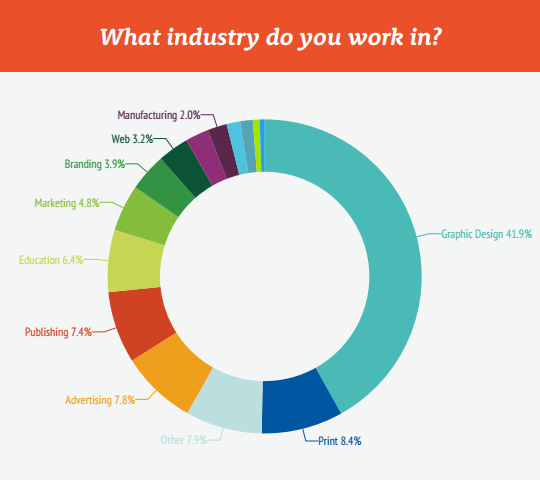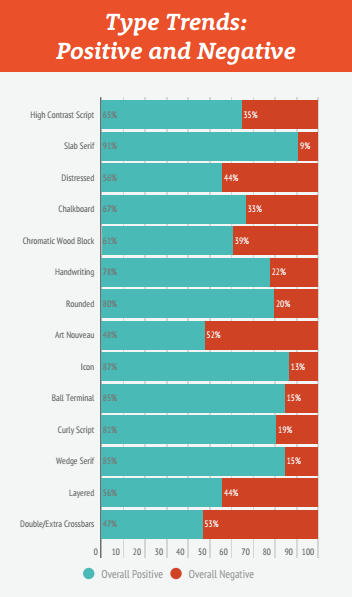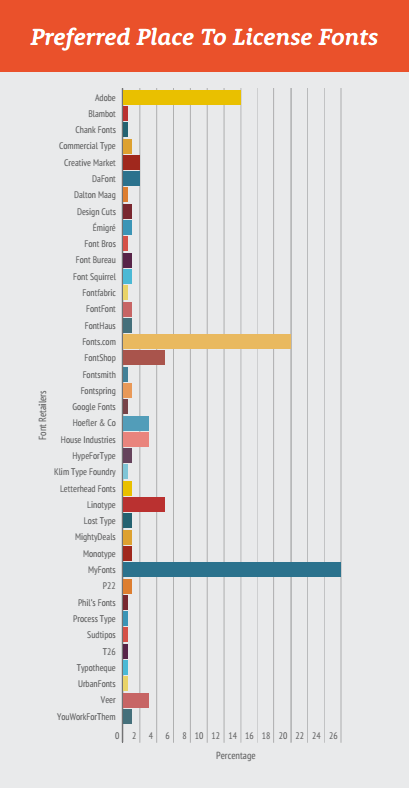Survey: Typographic Trends 2016
What’s popular regarding typography right now? Extensis, a provider of app solutions for font management, has conducted a survey in the creative scene and has come to impressive results. All the survey results, for which about 2,000 creative people from different branches were asked, can be downloaded for free in the PDF file Typographic Trends.
Fonts are Still Used for Printing
Jim Kidwell, who created the survey Typographic Trends for Extensis, has invited participants from the company’s customer database. That’s a smart approach as these are exactly the people that deal with fonts and typography every single day. Furthermore, that’s why it’s not surprising that 40 percent of the participants come from the graphic design sector, followed by print, advertising, and publishing.
An interesting aspect is that over 90 percent of participants use fonts for print, about 80 percent use it to design logos and two-thirds for the embedding in PDF files. The usage of fonts on websites is only about 55 percent, even though web fonts have been supported by all browsers for a couple of years now, and the supply of free and paid web fonts is rather large.

The survey doesn’t tell you whether the reason is the popular subscription model, which is commonly seen with commercial fonts, or not.
Typographic Trends: Serif Heavy Fonts are Very Popular, Fonts Without Serifs are Welcome in the Future
But which fonts are especially popular amongst graphic designers and advertisers? Here, serif heavy fonts are very popular amongst over 90 percent of the participants. This goes well alongside the trend that we noticed in graphic and web design. Whenever a design is supposed to be trendy, serif fonts are used.

Art nouveau fonts, as well as fonts with double or more additional lines, were rated especially bad. The negative rating is probably due to the limited readability of these fonts.

As every trend dies out at one point, Kidwell also asked which fonts are currently overused. Fonts in chalkboard style are some of the top answers here.
When it comes to which fonts the people want to see in the future, fonts without serifs, being the complete opposite of the still very popular serif fonts, are in the top position.
Typography: a Very Emotional Matter
The survey Typographic Trends didn’t only allow the participants to answer via multiple choice. They were also able to communicate their thoughts on the presented font styles. Kidwell has published a collection of these thoughts and comments as well.
Kidwell has published ten participant’s opinions for every single one of the 14 fonts that represented one style each. The opinions include interesting views, as to why someone especially likes or dislikes a font. Here, it becomes evident that typography is a highly emotional issue for designers.
One participant can’t contain himself when it comes to chalkboard fonts, and comments the following: “… please destroy all of these fonts.” Many creative people will be this passionate about fonts, especially when it comes to very unpopular ones.
Mainly Purchasing Fonts From the Big Suppliers
Another fascinating segment of the survey deals with the question where and how the participants purchase fonts. Here, it becomes apparent that there are three large main suppliers that have the edge over the competition. MyFonts, Fonts.com, and Adobe are by far the most popular providers. If you keep in mind that MyFonts, and Fonts.com both belong to the Monotype group, the font market is basically shared between two large companies.

Smaller providers only have minuscule shares which, for the most part, lie below five percent.
Most of the participants license entire families, just when they are needed. It is very rare that entire libraries are licensed, or that only open source fonts are used. The fact that about 6 percent of the asked people don’t license fonts at all is left open for you to judge.
Conclusion
On a total of 31 pages, there are plenty more interesting results on fonts, and how they are used at the moment. The survey Typographic Trends also answers the question which font designer is currently at the top in the eyes of the participants. You can get the results of the study Typographic Trends on the Extensis website. All you need to do to download the file is enter your email address.
(dpe)
